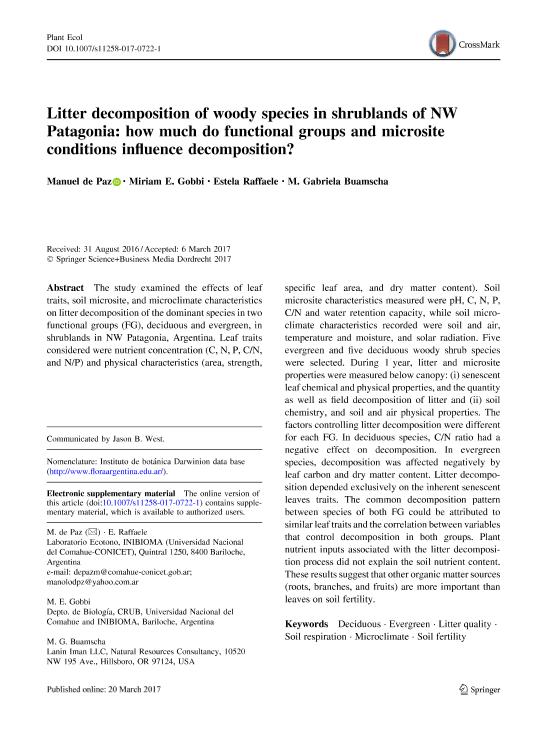Mostrar el registro sencillo del ítem
dc.contributor.author
de Paz, Manuel

dc.contributor.author
Gobbi, Miriam E.

dc.contributor.author
Raffaele, Estela

dc.contributor.author
Buamscha, G.
dc.date.available
2018-11-05T19:19:31Z
dc.date.issued
2017-06
dc.identifier.citation
de Paz, Manuel; Gobbi, Miriam E.; Raffaele, Estela; Buamscha, G.; Litter decomposition of woody species in shrublands of NW Patagonia: how much do functional groups and microsite conditions influence decomposition?; Springer; Plant Ecology; 218; 6; 6-2017; 699-710
dc.identifier.issn
1385-0237
dc.identifier.uri
http://hdl.handle.net/11336/63667
dc.description.abstract
The study examined the effects of leaf traits, soil microsite, and microclimate characteristics on litter decomposition of the dominant species in two functional groups (FG), deciduous and evergreen, in shrublands in NW Patagonia, Argentina. Leaf traits considered were nutrient concentration (C, N, P, C/N, and N/P) and physical characteristics (area, strength, specific leaf area, and dry matter content). Soil microsite characteristics measured were pH, C, N, P, C/N and water retention capacity, while soil microclimate characteristics recorded were soil and air, temperature and moisture, and solar radiation. Five evergreen and five deciduous woody shrub species were selected. During 1 year, litter and microsite properties were measured below canopy: (i) senescent leaf chemical and physical properties, and the quantity as well as field decomposition of litter and (ii) soil chemistry, and soil and air physical properties. The factors controlling litter decomposition were different for each FG. In deciduous species, C/N ratio had a negative effect on decomposition. In evergreen species, decomposition was affected negatively by leaf carbon and dry matter content. Litter decomposition depended exclusively on the inherent senescent leaves traits. The common decomposition pattern between species of both FG could be attributed to similar leaf traits and the correlation between variables that control decomposition in both groups. Plant nutrient inputs associated with the litter decomposition process did not explain the soil nutrient content. These results suggest that other organic matter sources (roots, branches, and fruits) are more important than leaves on soil fertility.
dc.format
application/pdf
dc.language.iso
eng
dc.publisher
Springer

dc.rights
info:eu-repo/semantics/openAccess
dc.rights.uri
https://creativecommons.org/licenses/by-nc-sa/2.5/ar/
dc.subject
Deciduous
dc.subject
Evergreen
dc.subject
Litter Quality
dc.subject
Microclimate
dc.subject
Soil Fertility
dc.subject
Soil Respiration
dc.subject.classification
Otras Ciencias Biológicas

dc.subject.classification
Ciencias Biológicas

dc.subject.classification
CIENCIAS NATURALES Y EXACTAS

dc.title
Litter decomposition of woody species in shrublands of NW Patagonia: how much do functional groups and microsite conditions influence decomposition?
dc.type
info:eu-repo/semantics/article
dc.type
info:ar-repo/semantics/artículo
dc.type
info:eu-repo/semantics/publishedVersion
dc.date.updated
2018-10-23T16:16:24Z
dc.identifier.eissn
1573-5052
dc.journal.volume
218
dc.journal.number
6
dc.journal.pagination
699-710
dc.journal.pais
Alemania

dc.journal.ciudad
Berlin
dc.description.fil
Fil: de Paz, Manuel. Consejo Nacional de Investigaciones Científicas y Técnicas. Centro Científico Tecnológico Conicet - Patagonia Norte. Instituto de Investigaciones en Biodiversidad y Medioambiente. Universidad Nacional del Comahue. Centro Regional Universidad Bariloche. Instituto de Investigaciones en Biodiversidad y Medioambiente; Argentina
dc.description.fil
Fil: Gobbi, Miriam E.. Consejo Nacional de Investigaciones Científicas y Técnicas. Centro Científico Tecnológico Conicet - Patagonia Norte. Instituto de Investigaciones en Biodiversidad y Medioambiente. Universidad Nacional del Comahue. Centro Regional Universidad Bariloche. Instituto de Investigaciones en Biodiversidad y Medioambiente; Argentina
dc.description.fil
Fil: Raffaele, Estela. Consejo Nacional de Investigaciones Científicas y Técnicas. Centro Científico Tecnológico Conicet - Patagonia Norte. Instituto de Investigaciones en Biodiversidad y Medioambiente. Universidad Nacional del Comahue. Centro Regional Universidad Bariloche. Instituto de Investigaciones en Biodiversidad y Medioambiente; Argentina
dc.description.fil
Fil: Buamscha, G.. Lanin Iman; Estados Unidos
dc.journal.title
Plant Ecology

dc.relation.alternativeid
info:eu-repo/semantics/altIdentifier/url/https://link.springer.com/article/10.1007%2Fs11258-017-0722-1
dc.relation.alternativeid
info:eu-repo/semantics/altIdentifier/doi/http://dx.doi.org/10.1007/s11258-017-0722-1
Archivos asociados
